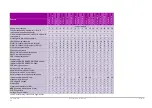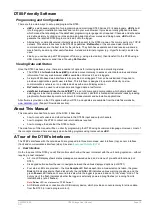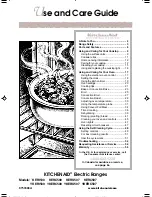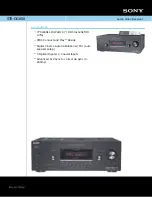
UM-0085-B09
DT80 Range User Manual
Page 18
RG
DT80-Friendly Software
Programming and Configuration
There are three main ways to set up and program the DT80.
•
dEX
is a web based application for programming and monitoring DT80 Series 2/ 3/ 4 data loggers.
dEX
is built
into the logger (no installation required) and runs in your web browser. It provides a totally graphical interface,
which means that knowledge of the dataTaker programming language is not required. Channels and schedules
are defined simply by clicking on icons and making selections from menus and dialog boxes;
dEX
will then
generate the required DT80 program and load it onto the logger.
•
Alternatively, commands entered interactively and then sent to the DT80 via one of its comms ports or a TCP/IP
network. This allows full access to the DT80's capabilities.
DeTransfer
, or the enhanced web interface's
command window, are the best tools for the job here. They both have separate send and receive windows, a
macro facility, and many other useful features. A standard terminal program (e.g. HyperTerminal) can also be
used.
•
Finally, you can develop a DT80 program off-line (e.g. using a text editor), then transfer it to the DT80 using a
USB memory device or send it as a file using
DeTransfer
.
Viewing Data and Status
Once the DT80 has been set up, there are a number of options for retrieving data and monitoring status:
•
The DT80's inbuilt
web interface (
dEX
)
provides a convenient way to access current data values and status
information from any web browser.
dEX
is available on Series 2, 3 and 4 loggers.
•
A simple HTML-based web interface is also provided on all loggers. This can be customised if required to
provide an application-specific user interface. This interface is designed to operate efficiently on slow
communications networks or on portable devices with a small display screen.
•
DeTransfer
can be used to view real-time and logged data in text format.
•
dataTaker Instrument driver for LabVIEW™
is a set of drivers and documentation which allows dataTaker
data loggers to be incorporated in a LabVIEW environment. LabVIEW is National Instruments' industry-leading
graphical software development environment for measurement and automation applications.
All software is provided on the CD supplied with your DT80, and updates are available from the dataTaker website,
About This Manual
This manual is intended for all users of the DT80. It describes:
•
how to connect sensors and other devices to the DT80's input and output channels.
•
how to program the DT80 to collect and return data as required.
•
how to manage the data that the DT80 collects.
The main focus of this manual will be on directly programming the DT80 using its command language. However, most of
the concepts discussed here also apply when building programs using tools such as
dEX
.
A Tour of the DT80's Interfaces
The DT80's interfaces with the outside world are grouped into three main areas: user interface (top), sensor interface
(front) and communications interface (side). See also
.
User Interface
On the top panel of the DT80 you will find controls which allow the user to interact with the unit during operation – without
requiring a host computer:
•
A 2-line LCD display shows status messages, measured values, and a menu of pre-defined functions (not
DT81)
•
Six keypad buttons allow the user to navigate between the various displayed options (not DT81)
•
Four status LEDs are provided – the blue
Sample
LED flashes each time a measurement is taken, the green
Disk
LED indicates internal flash disk activity, the red
Attn
LED indicates various warning conditions, and the
green
Power
LED flashes at 3 second intervals while the logger is powered and not in low "sleep" mode. The
duty cycle of the flash indicates whether the logger is externally powered (long flashes) or running from its
internal battery (short flashes).
Note:
Power
LED is not present on DT80 Series 1
.
•
A USB socket allows connection of a USB memory device, which provides a convenient way to retrieve data
from the DT80 (or load a program onto it).
















































